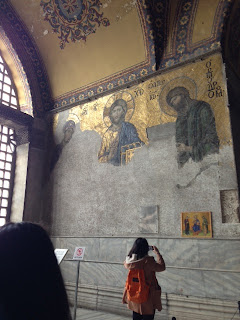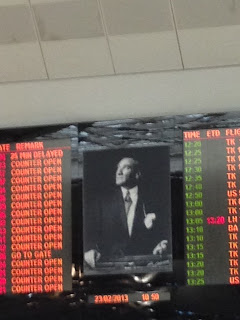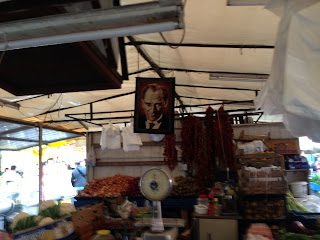Appropriately, one of the first pieces of art that I saw in Turkey-- although I guess it's not really a piece of art but a standardized staple of Turkish culture -- was a painting of the father of Modern Turkey, Mustafa Kamal Ataturk, which we saw at Robert College. What's I thought was interesting about it was that there are apparently several different distinct "types" of Ataturk paintings that are churned out and disseminated all throughout Turkey; for example, I've seen a bunch of depictions of him that look exactly like this in restaurants, private houses or museums. Paintings of Ataturk are all over -- on churches, houses, in shops, and very commonly under flags. My host from Robert College (Safak) says "It's a show of respect to the most famous man in Turkish history." I have a few other photos of other "types" that I saw in Izmir, too. The small cutout of a figure I'm holding up is a present from a first grade class at First Program: his name is Flat Stanley and I took him around during the trip, taking photos of him to send to the first graders. He will make a few other appearances throughout this album.
 |
| Me, Stanley, two classmates, and our chaperone Mrs. DeVoe with the man himself. |
------------------------------------------------------------------------------------------------------------------------
Here's one of the many huge medallions that we saw inscribed with calligraphic gold detailing that were all hanging on the walls of the Haghia Sophia -- placed geometrically throughout the mosque and bearing the name of the Prophet Mohammed, various caliphs, and Mohammed's grandkids.
--------------------------------------------------------------------------------------------------------------------------
one of the the more skillful architectural features I saw in the Sophia...what the builders apparently did is cut out very thin sheets of one piece of stone, which would inevitably have the same marbling as the original (the thinness is shown in the left picture). they would then place two sheets, one flipped, next to each other in order to create the rorscharch-y pattern on the right.

---------------------------------------------------------------------------------------------------------------------------
it's hard to see exactly, but many of the vaulted archways inside the mosque were painted in such a way as to introduce to the viewer's eye the illusion of three-dimensionality, using trompe l'oei -- a feature i later saw in friezes in the quaint "circumcision room" at the topkapi palace.
 | |||

---------------------------------------------------------------------------------------------------------------------------
on the right, a very beautiful mosaic, called the deesis in the haghia sophia. up close, the gold flakes were incredibly fine. i loved how soft the expressions of mary and john were. apparently, the deesis marks the beginning of a trend towards renaissance depictions in byzantine art -- an interesting reversal if you compare its prominence to the slashed-out faces of the saints torn off by ottoman muslims (this relief, shown on the right was in the museum of the temple of pergamon, in modern pergamon or bergama as the turks call it).

--------------------------------------------------------------------------------------------------------------------------
An imposing column featuring the head of Greek gorgon Medusa that we saw in the Basilica Cistern southwest of the Haghia Sophia. I loved the feel of the cistern -- cavernous, dark, with lights flickering and casting long shadows into the water where fish darted around under the domed, looming roof.
 | |
| The cistern. |
 |
| The gorgon
head. According to the pamphlet at the site, it's placed upside down to
dilute the power of the Gorgon's paralyzing gaze. - |
we saw this sculpture in the ruins of ephesus (or efes): it's a relief of the roman goddess nike, who was the goddess of victory, symbolized by the palm frond she's holding. it's commonly known that she was the inspiration for the shoe company (kind of a step down, in my opinion) but what was a surprise to us was that apparently her swooping pose in this sculpture was the inspiration for nike's famous swoosh/check-mark symbol. one of the more, uh, tangible ancient-contemporary links we experienced.
---------------------------------------------------------------------------------------------------------
snapshots i took of an art exhibition we saw while walking in downtown kusadasi. this was probably the only "contemporary" art we managed to see during the trip, though i thought i recognized some of the floral patterns as common themes in turkish art -- regardless, it was a lovely surprise seeing the splash of color and graffiti in the middle of the metropolis.





.JPG)





